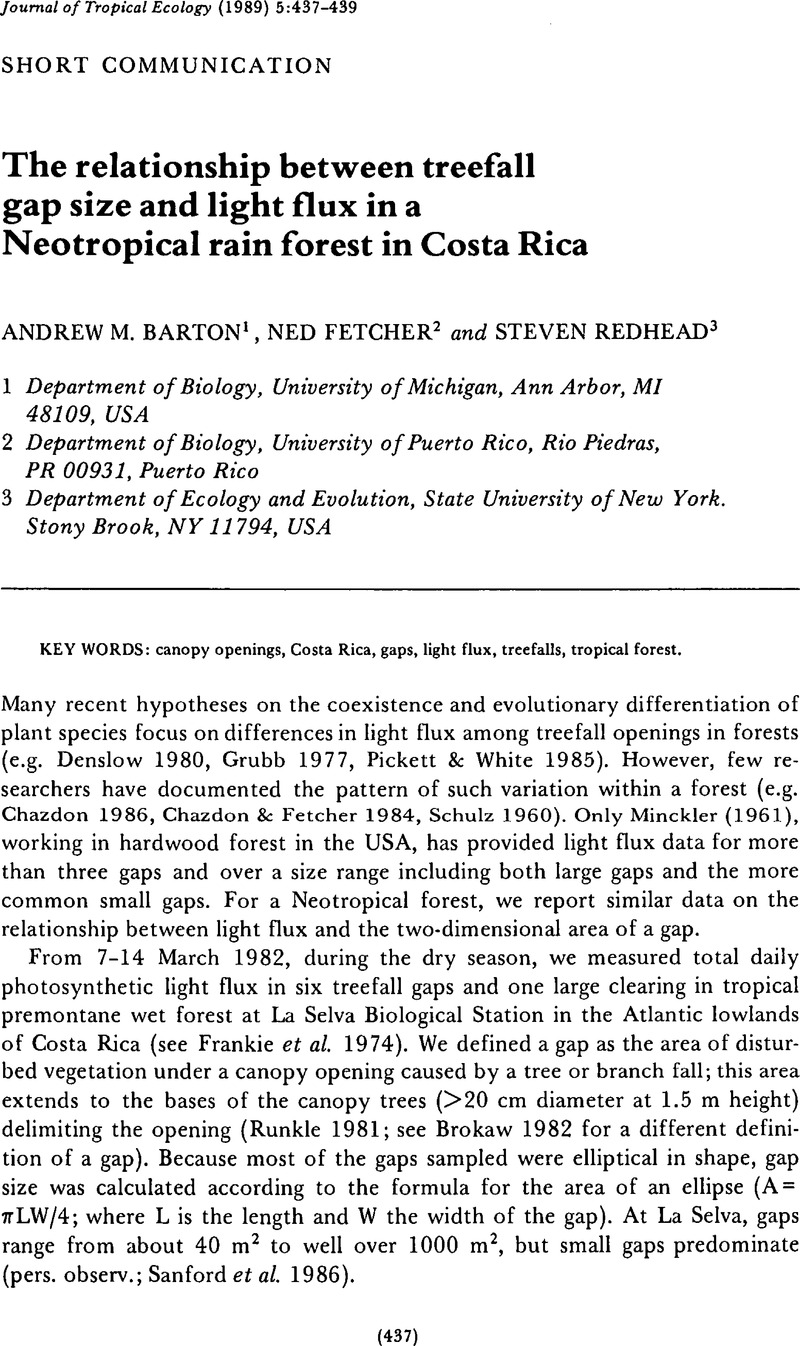Crossref Citations
This article has been cited by the following publications. This list is generated based on data provided by Crossref.
Remmert, H.
1991.
The Mosaic-Cycle Concept of Ecosystems.
Vol. 85,
Issue. ,
p.
1.
Brown, Nick
1993.
The implications of climate and gap microclimate for seedling growth conditions in a Bornean lowland rain forest.
Journal of Tropical Ecology,
Vol. 9,
Issue. 2,
p.
153.
Maginnis, Stewart
1994.
Understorey condition scoring of Ghanaian lowland tropical moist forest during stock survey: a technique for regulating the allowable cut in ecologically and structurally degraded production forest.
Forest Ecology and Management,
Vol. 70,
Issue. 1-3,
p.
89.
Holmes, Tyson H.
1995.
Woodland canopy structure and the light response of juvenileQuercus lobata(Fagaceae).
American Journal of Botany,
Vol. 82,
Issue. 11,
p.
1432.
Strauss-Deberiedetti, Silvia
and
Bazzaz, Fakhri A.
1996.
Tropical Forest Plant Ecophysiology.
p.
162.
Bellingham, P. J.
Tanner, E. V. J.
Rich, P. M.
and
Goodland, T. C. R.
1996.
Changes in light below the canopy of a Jamaican montane rainforest after a hurricane.
Journal of Tropical Ecology,
Vol. 12,
Issue. 5,
p.
699.
Dai, Xiaobing
1996.
Influence of light conditions in canopy gaps on forest regeneration: a new gap light index and its application in a boreal forest in east-central Sweden.
Forest Ecology and Management,
Vol. 84,
Issue. 1-3,
p.
187.
Chazdon, Robin L.
Pearcy, Robert W.
Lee, David W.
and
Fetcher, Ned
1996.
Tropical Forest Plant Ecophysiology.
p.
5.
Martinez-Ramos, Miguel
and
Cristiän, Samper K.
1997.
Tree Life History Patterns and Forest Dynamics.
Journal of Sustainable Forestry,
Vol. 6,
Issue. 1-2,
p.
85.
Denslow, Julie S.
Ellison, Aaron M.
and
Sanford, Robert E.
1998.
Treefall gap size effects on above‐ and below‐ground processes in a tropical wet forest.
Journal of Ecology,
Vol. 86,
Issue. 4,
p.
597.
Schnitzer, Stefan A.
Dalling, James W.
and
Carson, Walter P.
2000.
The impact of lianas on tree regeneration in tropical forest canopy gaps: evidence for an alternative pathway of gap‐phase regeneration.
Journal of Ecology,
Vol. 88,
Issue. 4,
p.
655.
Mizunaga, Hiromi
2000.
Prediction of PPFD variance at forest floor in a thinned Japanese cypress plantation.
Forest Ecology and Management,
Vol. 126,
Issue. 3,
p.
309.
Lewis, Simon L.
and
Tanner, Edmund V. J.
2000.
EFFECTS OF ABOVE- AND BELOWGROUND COMPETITION ON GROWTH AND SURVIVAL OF RAIN FOREST TREE SEEDLINGS.
Ecology,
Vol. 81,
Issue. 9,
p.
2525.
Schnitzer, Stefan A.
and
Carson, Walter P.
2001.
TREEFALL GAPS AND THE MAINTENANCE OF SPECIES DIVERSITY IN A TROPICAL FOREST.
Ecology,
Vol. 82,
Issue. 4,
p.
913.
Venâncio Martins, Sebastião
and
Ribeiro Rodrigues, Ricardo
2002.
Gap-phase regeneration in a semideciduous mesophytic forest, south–eastern Brazil.
Plant Ecology,
Vol. 163,
Issue. 1,
p.
51.
Ishizuka, Moriyoshi
Ochiai, Yukihito
and
Utsugi, Hajime
2002.
Diversity and Interaction in a Temperate Forest Community.
Vol. 158,
Issue. ,
p.
229.
DALLING, J. W.
WINTER, K.
and
HUBBELL, S. P.
2004.
Variation in growth responses of neotropical pioneers to simulated forest gaps.
Functional Ecology,
Vol. 18,
Issue. 5,
p.
725.
Dalling, James W.
and
Burslem, David F. R. P.
2005.
Biotic Interactions in the Tropics.
p.
65.
., Rafia Azmat
., Yasmeen Akhtar
., Rukhsana Talat
and
., Fahim Uddin
2005.
The Inhibition of Bean Plant Metabolism by Cd Metal and Atrazine: I. The Effect of Atrazine with Cd Metal on Growth, Photosynthesis, Nutritional Level and Rhizosphere of Soil.
Biotechnology(Faisalabad),
Vol. 4,
Issue. 3,
p.
238.
de Lima, Renato A. Ferreira
2005.
Gap size measurement: The proposal of a new field method.
Forest Ecology and Management,
Vol. 214,
Issue. 1-3,
p.
413.



